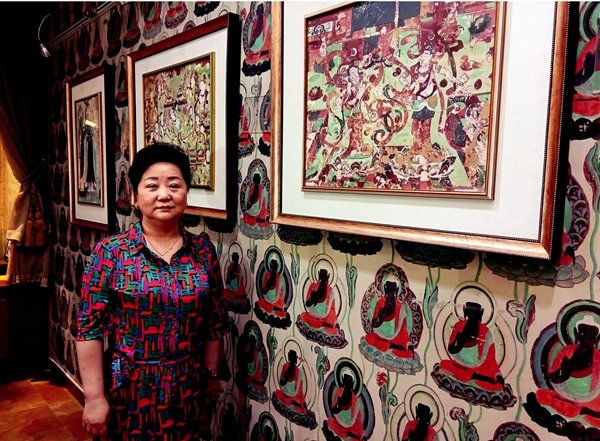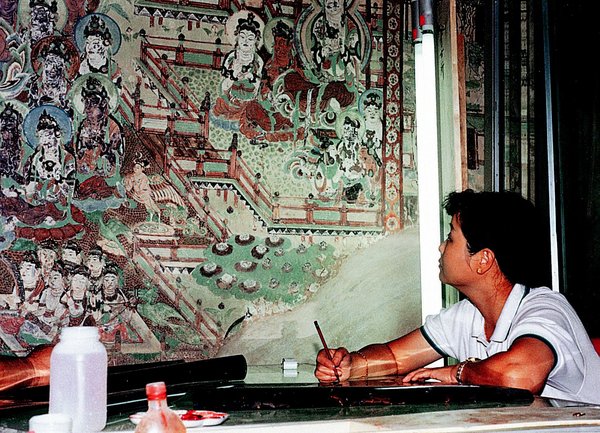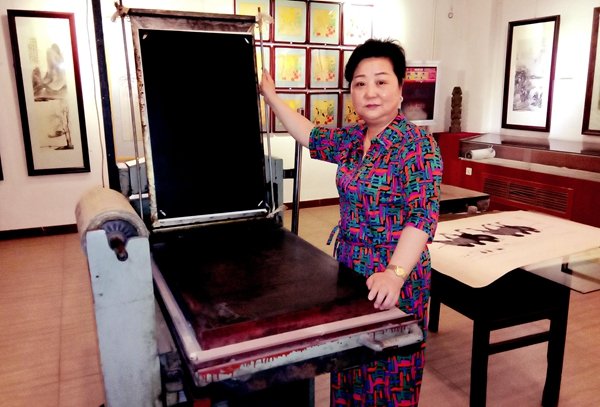 |
| Li Dongfang poses for a photo before paintings. [For Women of China] |
One evening, 35 years ago, Li Dongfang, a then-26-year-old woman from Beijing, arrived in Dunhuang, in Northwest China's Gansu Province. It was her first visit to Dunhuang. She had never expected she would spend the next 24 years working in the tough environment in the desert. Li had quit her decent job in Beijing, and had put down "roots" in Dunhuang. She used collotype techniques, regarded as a world cultural heritage, to restore marvelous mural paintings in the Mogao Grottoes.
Collotype refers to a photomechanical process for making prints directly from a hardened film of gelatin, or other colloid, that has ink-receptive and ink-repellent parts.Li, now in her sixties, is an inheritor and innovator of classic, world-level collotype techniques. She has used the techniques to repair and restore various national treasures, including mural paintings in the Mogao Grottoes. She hopes to pass on the techniques to younger generations. She also hopes the collotype techniques developed in China, during the past several decades, will be included, as an independent item, on the list of world intangible cultural heritage.
 |
| An old photo of Li Dongfang [For Women of China] |
First Encounter
Collotype originated in the West, and it was imported by China near the end of the 19th century. Compared with modern hectograph (duplicator consisting of a gelatin plate, from which ink can be taken to make a copy), collotype adopts photography skills to achieve more exquisite and smooth layers of prints. Li says collotype requires delicate manual work, and technicians must grasp excellent skills in painting and color identification.
Li began working at the National Cultural Heritage Administration in 1974. She became one of the first group of technicians required to learn collotype techniques at the Palace Museum.
What was her first impression of the techniques? "Too difficult! It's almost impossible to grasp the techniques." Li noted she spent much of her first three years at Palace Museum practicing basic sketch-drawing skills. After that, she began learning how to use collotype to produce copies of the documents kept in the museum's archive.
Before she could copy manuscripts written on letter paper with printed lines, she first had to take photos of the manuscripts, and she had to try very hard to remove the lines on photographic plates. At that time, there was no computer-drawing software. Li had to rely on her own eyes and hands to complete the work. She spent another two years improving her skills, and she gradually deepened her interest in collotype techniques.
Heading to Dunhuang
In 1983, Li read an article in People's Daily, which reported on Japanese artist Hirayama Ikuo's visit to the Mogao Grottoes . The artist suggested techniques from Japan could help produce prints of the mural paintings in Dunhuang. Li, who was working in the cultural relics restoration industry, asked herself why China could not develop its own collotype techniques to restore the mural paintings.
Li wrote a letter to Duan Wenjie, then-director of Dunhuang Academy. Half a year later, she received a reply from the academy, which approved and supported her suggestion. Li traveled to Dunhuang by train. It took her three days to travel from Beijing to the Gobi desert in Northwest China.
After a discussion with Dunhuang Academy's experts, Li was asked to first try to restore fantan pipa, a classic mural painting in Cave 112. Li spent more than two months working day and night in the cave. She took a lot of photos to compare against the original painting, and to determine the colors and patterns to duplicate the painting. It was extremely difficult for her to get used to living in such a tough environment. She could not take a nice shower during those two months. Her nose often bled due to the dry weather.
Two months later, Li took the plate she had produced back to Beijing. Based on the plate, she printed images of the original mural. She perfected the images according to the original painting. It took her more than eight months to complete a collotype duplicate of the classic mural in Cave 112. Experts of Dunhuang Academy compared the collotype duplicate Li had made with the original mural painting of fantan pipa. They were excited as they found Li's work looked perfectly the same with the mural.
To help restore more paintings in the Mogao Grottoes, Li quit her job in Beijing and relocated to Dunhuang. Life was still hard . Every day, Li walked half an hour from her home to the Mogao Grottoes. To avoid heatstroke, she wore a wet towel on her head when she was walking in the desert. However, the towel always dried quickly under the strong sunlight. Due to poor nutrition and excessive work, Li's eyesight diminished dramatically. She could only see blurred shadows of people who were sitting opposite to her.
Despite the difficulties, Li persisted in working in Dunhuang for more than two decades. She produced duplicate prints of classic mural paintings in nine caves. Her prints were collected by relevant government departments as precious references of cultural relics.
Taking Techniques Global
In 2008, after Li spent all of the money she had producing duplicate prints in Dunhuang, she returned to Beijing with a huge number of photos and other reference materials. She used collotype techniques to restore many other national treasures.
"Collotype techniques have been developed during the past century. However, only 200-plus technicians, throughout the world, are still working on these techniques. Only a few grasp the complete procedures of producing a traditional collotype print," Li says. She hopes the techniques will be passed down to younger generations.
Since she first learned collotype, when she was 17, Li has dedicated more than four decades of her life to constantly studying and improving the techniques. Over the past four decades, she has thought about, almost every day, how to produce a duplicate that looks exactly the same with the original item.
Nowadays, Li and and her team continue searching for Chinese cultural relics.By adopting collotype techniques, they hope to bring those national treasures back to their motherland. They also hope the collotype techniques developed in China will win applause on the world stage. For Li, collotype has been a career, for which she has dedicated her life.
 |
| Li Dongfang poses for a photo. [For Women of China] |
(Women of China)

